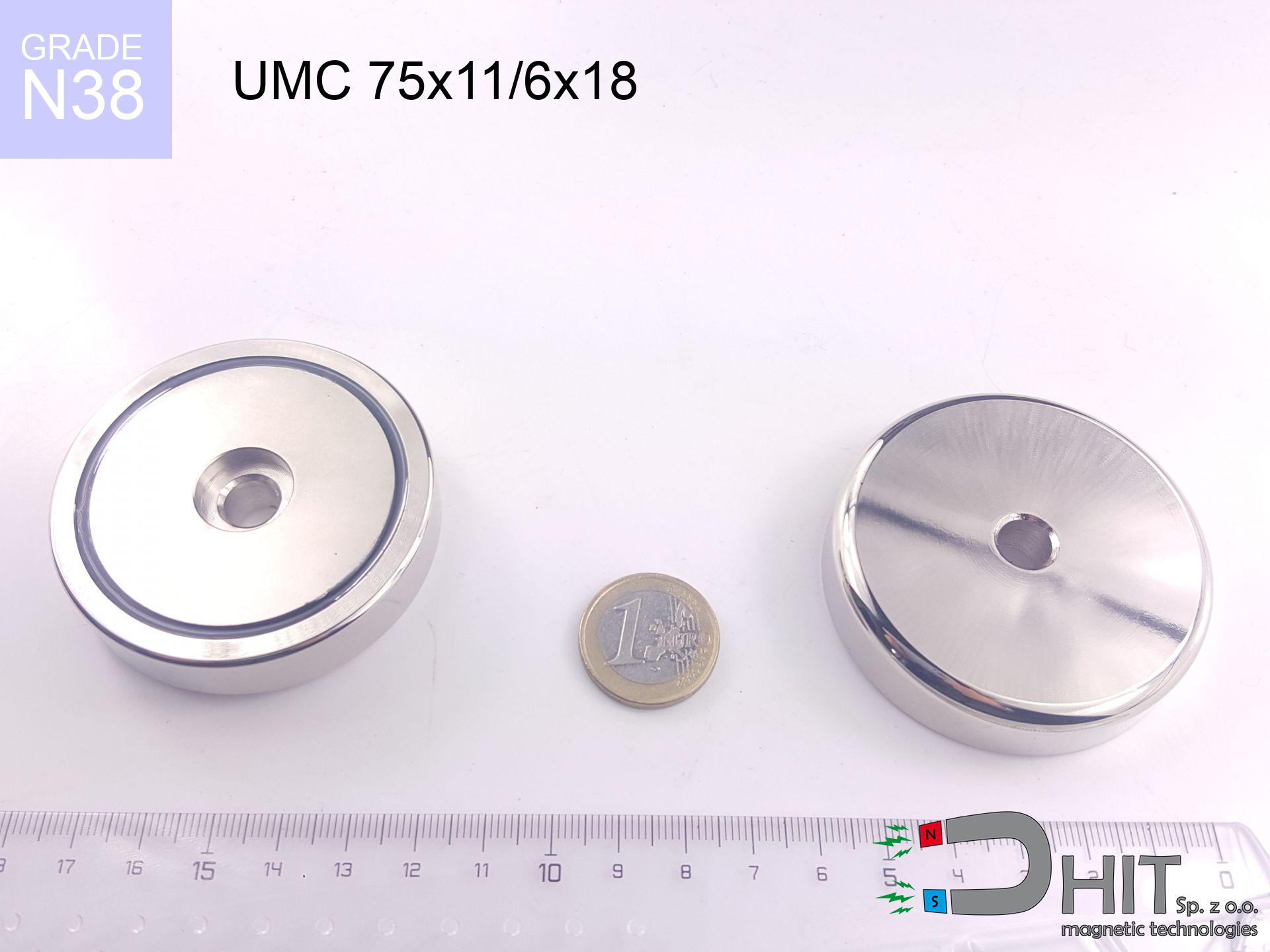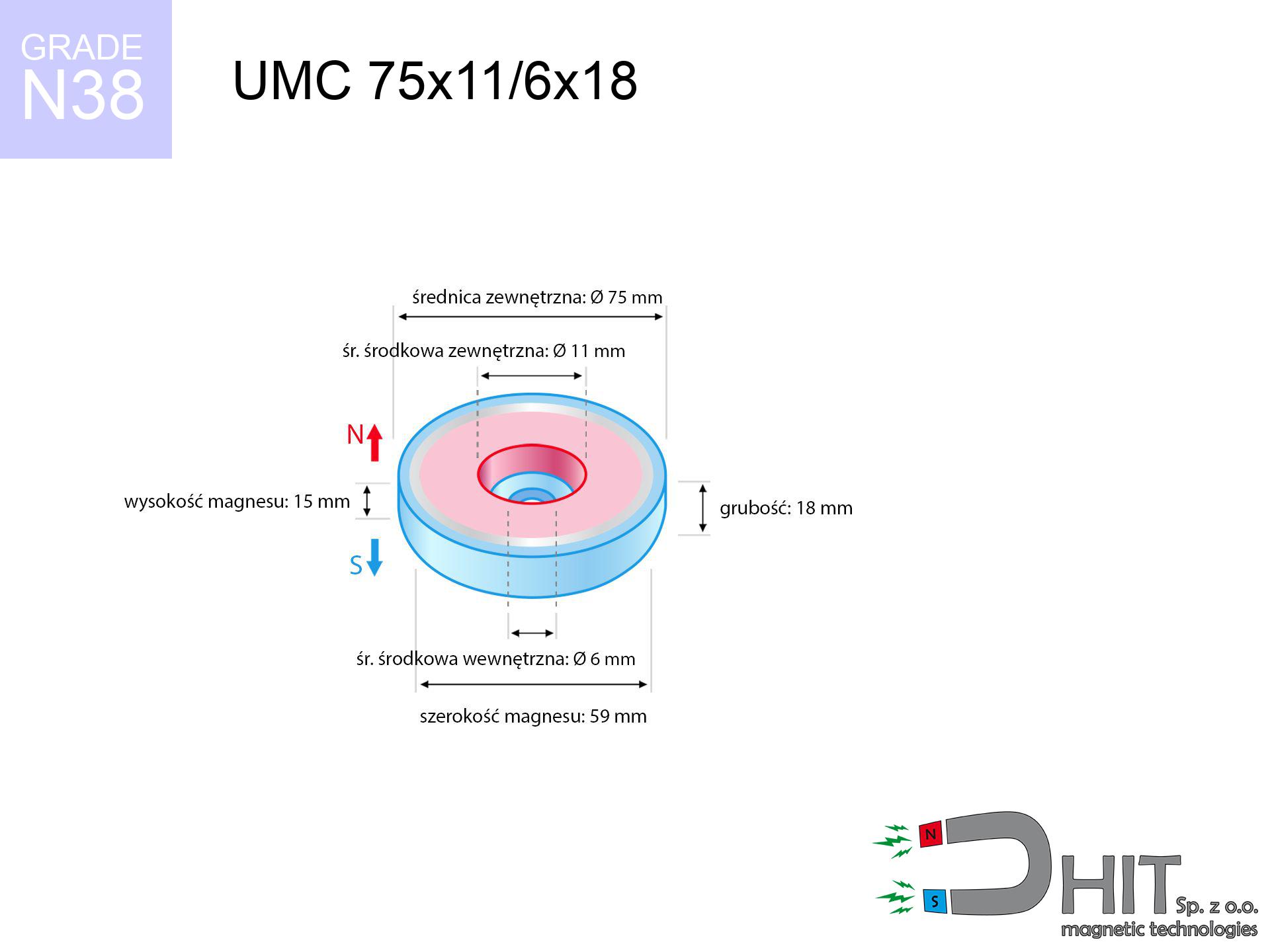UMC 75x11/6x18 / N38 - cylindrical magnetic holder
cylindrical magnetic holder
Catalog no 320414
GTIN/EAN: 5906301814702
Diameter
75 mm [±1 mm]
internal diameter Ø
11/6 mm [±1 mm]
Height
18 mm [±1 mm]
Weight
465 g
Load capacity
155.00 kg / 1520.03 N
Coating
[NiCuNi] Nickel
169.86 ZŁ with VAT / pcs + price for transport
138.10 ZŁ net + 23% VAT / pcs
bulk discounts:
Need more?
Give us a call
+48 888 99 98 98
if you prefer get in touch by means of
contact form
the contact page.
Lifting power along with shape of magnetic components can be estimated on our
our magnetic calculator.
Same-day processing for orders placed before 14:00.
Detailed specification - UMC 75x11/6x18 / N38 - cylindrical magnetic holder
Specification / characteristics - UMC 75x11/6x18 / N38 - cylindrical magnetic holder
| properties | values |
|---|---|
| Cat. no. | 320414 |
| GTIN/EAN | 5906301814702 |
| Production/Distribution | Dhit sp. z o.o. |
| Country of origin | Poland / China / Germany |
| Customs code | 85059029 |
| Diameter | 75 mm [±1 mm] |
| internal diameter Ø | 11/6 mm [±1 mm] |
| Height | 18 mm [±1 mm] |
| Weight | 465 g |
| Load capacity ~ ? | 155.00 kg / 1520.03 N |
| Coating | [NiCuNi] Nickel |
| Manufacturing Tolerance | ±1 mm |
Magnetic properties of material N38
| properties | values | units |
|---|---|---|
| remenance Br [min. - max.] ? | 12.2-12.6 | kGs |
| remenance Br [min. - max.] ? | 1220-1260 | mT |
| coercivity bHc ? | 10.8-11.5 | kOe |
| coercivity bHc ? | 860-915 | kA/m |
| actual internal force iHc | ≥ 12 | kOe |
| actual internal force iHc | ≥ 955 | kA/m |
| energy density [min. - max.] ? | 36-38 | BH max MGOe |
| energy density [min. - max.] ? | 287-303 | BH max KJ/m |
| max. temperature ? | ≤ 80 | °C |
Physical properties of sintered neodymium magnets Nd2Fe14B at 20°C
| properties | values | units |
|---|---|---|
| Vickers hardness | ≥550 | Hv |
| Density | ≥7.4 | g/cm3 |
| Curie Temperature TC | 312 - 380 | °C |
| Curie Temperature TF | 593 - 716 | °F |
| Specific resistance | 150 | μΩ⋅cm |
| Bending strength | 250 | MPa |
| Compressive strength | 1000~1100 | MPa |
| Thermal expansion parallel (∥) to orientation (M) | (3-4) x 10-6 | °C-1 |
| Thermal expansion perpendicular (⊥) to orientation (M) | -(1-3) x 10-6 | °C-1 |
| Young's modulus | 1.7 x 104 | kg/mm² |
Chemical composition
| iron (Fe) | 64% – 68% |
| neodymium (Nd) | 29% – 32% |
| boron (B) | 1.1% – 1.2% |
| dysprosium (Dy) | 0.5% – 2.0% |
| coating (Ni-Cu-Ni) | < 0.05% |
Ecology and recycling (GPSR)
| recyclability (EoL) | 100% |
| recycled raw materials | ~10% (pre-cons) |
| carbon footprint | low / zredukowany |
| waste code (EWC) | 16 02 16 |
Other proposals
Pros as well as cons of rare earth magnets.
Strengths
- They virtually do not lose power, because even after 10 years the performance loss is only ~1% (according to literature),
- Magnets perfectly defend themselves against loss of magnetization caused by foreign field sources,
- In other words, due to the glossy finish of gold, the element becomes visually attractive,
- The surface of neodymium magnets generates a maximum magnetic field – this is a distinguishing feature,
- Made from properly selected components, these magnets show impressive resistance to high heat, enabling them to function (depending on their shape) at temperatures up to 230°C and above...
- In view of the ability of free molding and adaptation to unique solutions, neodymium magnets can be manufactured in a broad palette of forms and dimensions, which expands the range of possible applications,
- Universal use in modern technologies – they are utilized in data components, drive modules, diagnostic systems, and complex engineering applications.
- Compactness – despite small sizes they provide effective action, making them ideal for precision applications
Limitations
- To avoid cracks under impact, we recommend using special steel housings. Such a solution protects the magnet and simultaneously increases its durability.
- Neodymium magnets lose their force under the influence of heating. As soon as 80°C is exceeded, many of them start losing their power. Therefore, we recommend our special magnets marked [AH], which maintain durability even at temperatures up to 230°C
- They rust in a humid environment - during use outdoors we advise using waterproof magnets e.g. in rubber, plastic
- Due to limitations in creating threads and complex shapes in magnets, we propose using cover - magnetic mechanism.
- Health risk resulting from small fragments of magnets can be dangerous, if swallowed, which is particularly important in the context of child safety. Additionally, tiny parts of these devices can disrupt the diagnostic process medical when they are in the body.
- Higher cost of purchase is one of the disadvantages compared to ceramic magnets, especially in budget applications
Pull force analysis
Highest magnetic holding force – what it depends on?
- on a base made of mild steel, optimally conducting the magnetic field
- with a cross-section minimum 10 mm
- characterized by even structure
- without the slightest air gap between the magnet and steel
- for force applied at a right angle (in the magnet axis)
- at ambient temperature approx. 20 degrees Celsius
Impact of factors on magnetic holding capacity in practice
- Gap between surfaces – even a fraction of a millimeter of distance (caused e.g. by veneer or dirt) drastically reduces the pulling force, often by half at just 0.5 mm.
- Angle of force application – highest force is available only during pulling at a 90° angle. The resistance to sliding of the magnet along the plate is usually many times lower (approx. 1/5 of the lifting capacity).
- Substrate thickness – for full efficiency, the steel must be sufficiently thick. Paper-thin metal limits the lifting capacity (the magnet "punches through" it).
- Metal type – different alloys reacts the same. High carbon content worsen the interaction with the magnet.
- Surface structure – the smoother and more polished the surface, the better the adhesion and higher the lifting capacity. Unevenness acts like micro-gaps.
- Thermal conditions – neodymium magnets have a sensitivity to temperature. When it is hot they lose power, and in frost gain strength (up to a certain limit).
Holding force was tested on the plate surface of 20 mm thickness, when a perpendicular force was applied, whereas under parallel forces the lifting capacity is smaller. Moreover, even a slight gap between the magnet’s surface and the plate decreases the lifting capacity.
Warnings
Magnet fragility
Despite metallic appearance, neodymium is delicate and cannot withstand shocks. Do not hit, as the magnet may shatter into hazardous fragments.
Fire warning
Fire warning: Rare earth powder is explosive. Do not process magnets in home conditions as this may cause fire.
Heat sensitivity
Watch the temperature. Exposing the magnet to high heat will permanently weaken its magnetic structure and pulling force.
Danger to pacemakers
Individuals with a heart stimulator should keep an absolute distance from magnets. The magnetism can interfere with the functioning of the implant.
Threat to electronics
Avoid bringing magnets near a wallet, laptop, or screen. The magnetism can destroy these devices and erase data from cards.
Safe operation
Before starting, check safety instructions. Sudden snapping can break the magnet or hurt your hand. Be predictive.
Phone sensors
A powerful magnetic field negatively affects the functioning of magnetometers in phones and GPS navigation. Maintain magnets close to a device to avoid damaging the sensors.
Warning for allergy sufferers
Warning for allergy sufferers: The Ni-Cu-Ni coating contains nickel. If an allergic reaction happens, cease handling magnets and use protective gear.
This is not a toy
Always store magnets away from children. Choking hazard is significant, and the effects of magnets connecting inside the body are very dangerous.
Hand protection
Big blocks can crush fingers instantly. Never put your hand betwixt two strong magnets.









